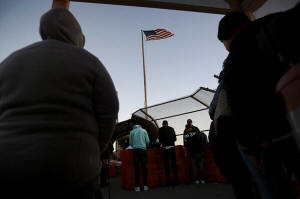Trump vows tariffs over immigration. What the numbers say about border
crossings, drugs and crime
 Send a link to a friend
Send a link to a friend
 [November 27, 2024]
By REBECCA SANTANA [November 27, 2024]
By REBECCA SANTANA
WASHINGTON (AP) — In a Monday evening announcement, President-elect
Donald Trump railed against Mexico and Canada, accusing them of allowing
thousands of people to enter the U.S.
Hitting a familiar theme from the campaign trail and his first term in
office, Trump portrayed the country's borders as insecure and immigrants
as contributing to crime and the fentanyl crisis. In an announcement
that could have stark repercussions, he threatened to impose 25% tariffs
on everything coming into the country from those two countries.
Trump's anti-immigration rhetoric has resonated with voters concerned
about immigration and crime. Yet there's more to the story than Trump's
short statement suggested.
A look at what the numbers and studies say about border crossings,
fentanyl smuggling and whether there's a connection between immigration
and crime:
Border crossings
The number of migrants crossing the U.S.-Mexico border is a key metric
watched intensely by both Republicans and Democrats.
U.S. Customs and Border Protection, an arm of the Department of Homeland
Security, releases monthly statistics that track everything from drug
seizures to cross-border trade. One of the metrics tracked is the number
of Border Patrol arrests or encounters each month with people entering
the country between the official border crossings — known as the ports
of entry.

The vast majority of those arrests happen at the southern border.
Those numbers have actually been falling this year under the Biden
administration. The Border Patrol made 56,530 arrests in October, which
is about a four-year low.
It hasn't always been like that. The Biden administration struggled to
bring down the growing number of migrants coming to the southern border.
A little less than a year ago, in December 2023, the Border Patrol made
about a quarter of a million arrests along the southern border — an
all-time high. Cross-border trade was damaged as border agents were
reassigned to help process migrants and train traffic was temporarily
shut down.
Since then, the numbers of people encountered at the southern border
have dropped and stayed down through a combination of stricter
enforcement on the Mexican side and asylum restrictions announced
earlier this year by the Biden administration.
Republicans put a caveat on those numbers.
They have frequently accused the Biden administration of using an app
called CBP One to let hundreds of thousands of people into the country
who otherwise wouldn't be allowed in. They've described the program
where 1,450 people a day can schedule an appointment to come into the
U.S. as essentially a way to keep the border encounter numbers
artificially low.
On the northern border, the numbers are much smaller. Border Patrol made
23,721 arrests between October 2023 and September 2024, compared with
10,021 the previous 12 months.
Trump also struggled to get a handle on illegal border crossings.
Arrests topped 850,000 in 2019, nearly triple the amount two years
earlier, though still far below the tally of more than 2 million for two
different years under Biden.
Drug smuggling
Trump and many Republicans have often portrayed the U.S.'s southern
border as wide open to drug smuggling. They have also linked immigrants
to drug smuggling and accused Mexico of doing little to stop it.
Much of America’s fentanyl is smuggled from Mexico.
The fentanyl scourge began well before Biden took office. Border
seizures have jumped sharply under Biden, which may partly reflect
improved detection. About 27,000 pounds (12,247 kilograms) of fentanyl
was seized by U.S. authorities in the 2023 government budget year,
compared with 2,545 pounds (1,154 kilograms) in 2019, when Trump was
president.
[to top of second column]
|

Migrants line up to present to U.S. agents, documents requesting an
appointment to apply for asylum, at the Paso del Norte international
bridge, in Ciudad Juarez, Mexico, Nov 5, 2024. (AP Photo/Christian
Chavez, File)

Cooperation between the Mexican and U.S. governments on fighting
drug smuggling undoubtedly suffered under President Andrés Manuel
López Obrador, who left office at the end of September.
Before López Obrador took office in December 2018, the U.S. worked
closely with Mexico’s military to take down drug capos.
But López Obrador, a nationalist and folksy populist, railed against
the violence set off by the drug war waged by his predecessors and
the Americans. He proposed addressing the root societal causes of
violence found in poverty and a lack of opportunity for young
people, in what he called “hugs, not bullets.”
For years, López Obrador denied that Mexico made fentanyl, despite
evidence to the contrary, including statements from his own security
officials. He blamed U.S. society, where he said families push
children out of home too early, for cultivating addicts.
It's only two months into the term of President Claudia Sheinbaum
but there are signs that she appears more willing to let the
military go after the cartels than her predecessor.
But while most of the fentanyl comes from Mexico, statistics show
that it is Americans who are doing the smuggling across the border.
According to the U.S. Sentencing Commission, 86.4% of people
sentenced for fentanyl trafficking crimes in a 12-month period
ending September 2023 were American citizens.
Crime and immigration
Trump also has argued that the influx of immigrants is causing a
crime surge in the U.S., although statistics show violent crime is
on the way down.
Texas is the only state that tracks crime by immigration status. A
study published by the National Academy of Sciences, based on Texas
Department of Public Safety data from 2012 to 2016, found people in
the U.S. illegally had “substantially lower crime rates than
native-born citizens and legal immigrants across a range of felony
offenses.”
While FBI statistics do not separate out crimes by the immigration
status of the assailant, there is no evidence of a spike in crime
perpetrated by migrants, either along the U.S.-Mexico border or in
cities seeing the greatest influx of migrants, like New York.
Studies have found that people living in the U.S. illegally are less
likely than native-born Americans to have been arrested for violent,
drug and property crimes.

Some crime is inevitable given the large population of immigrants.
There were an estimated 11 million people in the country illegally
in January 2022, according to the latest estimate by U.S. Homeland
Security Department. In 2022, the Census Bureau estimated the
foreign-born population at 46.2 million, or nearly 14% of the total,
with most states seeing double-digit percentage increases in the
last dozen years.
Republicans have highlighted high-profile crimes by immigrants such
as the February killing of 22-year-old Laken Riley in Georgia and
argued that any crime committed by someone in the country illegally
is a crime that shouldn't have happened.
A Venezuelan man who entered the country illegally was convicted and
sentenced to life in prison this month in Riley's killing.
__
Associated Press writer Christopher Sherman in Mexico City
contributed to this report.
All contents © copyright 2024 Associated Press. All rights reserved |